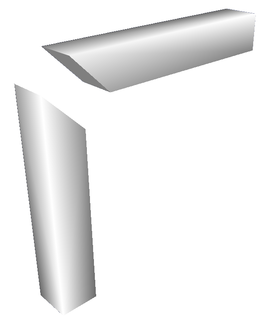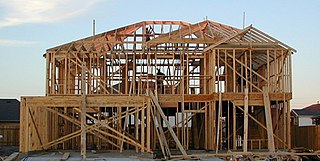
A skyscraper is a continuously habitable high-rise building that has over 40 floors and is taller than approximately 150 m (492 ft). Historically, the term first referred to buildings with 10 to 20 floors in the 1880s. The definition shifted with advancing construction technology during the 20th century. Skyscrapers may host commercial offices or residential space, or both. For buildings above a height of 300 m (984 ft), the term "supertall" can be used, while skyscrapers reaching beyond 600 m (1,969 ft) are classified as "megatall".

A wall is a structure that defines an area, carries a load, or provides shelter or security. There are many kinds of walls, including:

Monocoque, also structural skin, is a structural system where loads are supported through an object's external skin, similar to an egg shell. The word monocoque is a French term for "single shell" or "single hull".
First used in boats, a true monocoque carries both tensile and compressive forces within the skin and can be recognised by the absence of a load-carrying internal frame.

A chassis is the framework of an artificial object, which supports the object in its construction and use. An example of a chassis is a vehicle frame, the underpart of a motor vehicle, on which the body is mounted; if the running gear such as wheels and transmission, and sometimes even the driver's seat, are included, then the assembly is described as a rolling chassis.

A backpack—also called bookbag, knapsack, rucksack, rucksac, pack, sackpack or backsack—is, in its simplest frameless form, a cloth sack carried on one's back and secured with two straps that go over the shoulders, but it can have an external frame, internal frame, and there are bodypacks.

Carpentry is a skilled trade and a craft in which the primary work for performed is the cutting, shaping and installation of building materials during the construction of buildings, ships, timber bridges, concrete formwork, etc. Carpenters traditionally worked with natural wood and did the rougher work such as framing, but today many other materials are also used and sometimes the finer trades of cabinetmaking and furniture building are considered carpentry. In the United States, 98.5% of carpenters are male, and it was the fourth most male-dominated occupation in the country in 1999. In 2006 in the United States, there were about 1.5 million carpentry positions. Carpenters are usually the first tradesmen on a job and the last to leave. Carpenters normally framed post-and-beam buildings until the end of the 19th century; now this old fashioned carpentry is called timber framing. Carpenters learn this trade by being employed through an apprenticeship training—normally 4 years—and qualify by successfully completing that country's competence test in places such as the United Kingdom, the United States, Australia and South Africa. It is also common that the skill can be learned by gaining work experience other than a formal training program, which may be the case in many places.

In engineering, a truss is a structure that "consists of two-force members only, where the members are organized so that the assemblage as a whole behaves as a single object". A "two-force member" is a structural component where force is applied to only two points. Although this rigorous definition allows the members to have any shape connected in any stable configuration, trusses typically comprise five or more triangular units constructed with straight members whose ends are connected at joints referred to as nodes.

A traditional yurt or ger (Mongolian) is a portable, round tent covered with skins or felt and used as a dwelling by nomads in the steppes of Central Asia. The structure comprises an angled assembly or latticework of pieces of wood or bamboo for walls, a door frame, ribs, and a wheel possibly steam-bent. The roof structure is often self-supporting, but large yurts may have interior posts supporting the crown. The top of the wall of self-supporting yurts is prevented from spreading by means of a tension band which opposes the force of the roof ribs. Modern yurts may be permanently built on a wooden platform; they may use modern materials such as steam-bent wooden framing or metal framing, canvas or tarpaulin, Plexiglas dome, wire rope, or radiant insulation.
A frame story is a literary technique.

Timber framing and "post-and-beam" construction are traditional methods of building with heavy timbers, creating structures using squared-off and carefully fitted and joined timbers with joints secured by large wooden pegs. It is commonplace in wooden buildings from the 19th century and earlier. If the structural frame of load-bearing timber is left exposed on the exterior of the building it may be referred to as half-timbered, and in many cases the infill between timbers will be used for decorative effect. The country most known for this kind of architecture is Germany. Timber framed houses are spread all over the country except in the southeast.

The steel square is a tool used in carpentry. Carpenters use various tools to lay out structures that are square, many of which are made of steel, but the name steel square refers to a specific long-armed square that has additional uses for measurement, especially of various angles. Today the steel square is more commonly referred to as the framing square or carpenter's square. It consists of a long, wider arm and a shorter, narrower arm, which meet at an angle of 90 degrees. It can also be made of aluminum or polymers, which are light and resistant to rust.

A mitre joint is a joint made by beveling each of two parts to be joined, usually at a 45° angle, to form a corner, usually a 90° angle. For woodworking, a disadvantage of a mitre joint is its weakness, but it can be strengthened with a spline. There are two common variations of a splined mitre joint, one where the spline is long and runs the length of the mating surfaces and another where the spline is perpendicular to the joined edges.

Framing, in construction, is the fitting together of pieces to give a structure support and shape. Framing materials are usually wood, engineered wood, or structural steel. The alternative to framed construction is generally called mass wall construction, where horizontal layers of stacked materials such as log building, masonry, rammed earth, adobe, etc. are used without framing.
Tower International is a leading global manufacturer of engineered automotive structural metal components and assemblies primarily serving original equipment manufacturers (“OEMs”). Tower International offers their automotive customers a broad product portfolio, supplying body-structure stampings, frame and other chassis structures, and complex welded assemblies for small and large cars, crossovers, pickups, and sport utility vehicles.
Stechford Baptist Church is a small Baptist church in the Stechford area of Birmingham, England and is notable for a 40-year history of combating racism and promoting community cohesion in a British urban-deprived setting. In the vanguard of attempts from the 1960s to engage immigrant Caribbean communities within mainstream indigenous churches, it played a key role in opposing the National Front during the 1970s. By the 1980s and 1990s it achieved a 50%/50% balance of indigenous and non-indigenous membership and leadership, thereby contrasting sharply with a UK tendency towards majority-white and majority-black churches, where splits are typically in the 90/10 ratio. During the 1990s the church developed relationships with a number of black-led community groups which had grown out of the 1985 Handsworth riots, and from 2000 the church worked to support asylum-seeker rights. One of the church leaders, Mrs E C McGhie-Belgrave, was awarded the MBE in 2002 and subsequently the Queen's Golden Jubilee Award in 2004 for her contribution to community cohesion and Black-White issues in Birmingham.

A motorcycle frame is a motorcycle's core structure. It supports the engine, provides a location for the steering and rear suspension, and supports the rider and any passenger or luggage. Also attached to the frame are the fuel tank and battery. At the front of the frame is found the steering head tube that holds the pivoting front fork, while at the rear there is a pivot point for the swingarm suspension motion. Some motorcycles include the engine as a load-bearing stressed member; while some others bikes do not use a single frame, but instead have a front and a rear subframe attached to the engine.

A vehicle frame, also known as its chassis, is the main supporting structure of a motor vehicle, to which all other components are attached, comparable to the skeleton of an organism.

An overhang in architecture is a protruding structure which may provide protection for lower levels. Overhangs on two sides of Pennsylvania Dutch barns protect doors, windows, and other lower level structure. Overhangs on all four sides of barns is common in Swiss architecture. An overhanging eave is the edge of a roof, protruding outwards, beyond the side of the building generally to provide weather protection.

Log buildings and structures can be categorized as historic and modern. A diverse selection of their forms and styles with examples of architectural elements is discussed in the following articles.



















